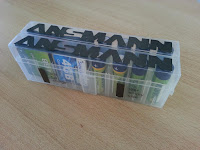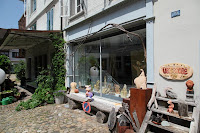For my flashes, which can't use an external pack, I normally have twelve AA size ones in my bag. Four will be in the flash itself and the other eight act as spares.
Sometimes, when things are moving fast and you need to grab another four penlights, what do you do? In the old days, I used to wrap an elastic band around them to keep them together . This wasn't the ideal solution because after a few months, the rubber would perish and the batteries would spill all over the floor.
Then I had the idea of keeping them in a slide box that originally held 36 mounted transparencies.
This method lasted me until I started using digital cameras and I also had to find space for the memory cards as well. I wanted to have something to store the penlights and the memory cards together.
I have now found the ideal solution. The German company Ansmann make a fantastic battery box that is light weight, slim and holds either AA, AAA's or memory cards or any combination thereof.
I bought three from my local branch of Pearl for Fr 4.95 each.
Three boxes slotted together
Once the labels are peeled (very easily) away, you will see marking to indicate if the batteries are full.
All in all, a wonderful little accessory that doesn't cost much and will last a very long time. It's one of those things that will stay in your camera bag for years to come. Thoroughly recommended.
Thanks for reading.














